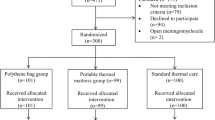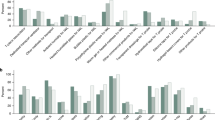Abstract
We compared the response of temperature adaptation in preterm infants using the polyethylene wrap with and without previous drying versus the sterile preheated field. Both groups of polyethylene use achieved a mean axillary temperature of 36.5°C at 30 minutes compared with 75 minutes for the group of traditional care. At 120 minutes, the incubator temperature was higher in those using preheated field, compared with infants in the polyethylene wrap with or without previous drying, (35.15°C, 34.20°C and 34.20°C respectively; P = 0.0001). No difference in axillary or incubator temperature was found between the groups using the polyethylene wrap.
Similar content being viewed by others
References
Mullany LC, Katz J, Khatry SK, LeClerq SC, Darmstadt GL, Tielsch JM. Neonatal hypothermia and associated risk factors among newborns of southern Nepal. BMC Med. 2010;8:43.
Watkinson M. Temperature control of premature infants in the delivery room. Clin Perinatol. 2006;33:43–53.
Vohra S, Roberts R, Zhang B, Janes M, Schmidt B. Heat loss prevention in the delivery room: A randomized controlled trial of polyethylene occlusive skin wrapping in very preterm infants. J Pediatr. 2004;145:750–3.
Mena P, Meneses R. Termoregulación del recién nacido (Thermoregulation of the newborn). Rev Chil Pediatr. 2002;73:184–191.
Norma oficial Mexicana NOM-007-SSA2-1993. Atención de la mujer durante el embarazo, parto y puerperium y del recién nacido (The woman’s attention during the pregnancy, childbirth and puerperio and of the newborn). Available from: http://www.salud.gob.mx/unidades/cdi/nom/007ssa23.html. Accessed May 8, 2009
Duman N, Utkutan S, Kumral A, Koroglu TF, Ozkan H. Polyethylene skin wrapping accelerates recovery from hypothermia in very low-birthweight infants. Pediatr Int. 2006;48:29–32.
Vohra S, Frent G, Campbell V, Abbott M, Whyte R. Effect of polyethylene occlusive skin wrapping on heat loss in very low birth weight infants at delivery: A randomized trial. J Pediatr. 1999;134:547–551.
Gathwala G, Singh G, Kunal, Agrawal N. Safety and efficacy of vinyl bags in prevention of hypothermia of preterm neonates at birth. Indian J Public Health. 2010;54:24–26.
Lenclen R, Mazraani M, Jugie M, Couderc S, Hoenn E, Carbajal R, et al. Use of a polyethylene bag: a way to improve the thermal environment of the premature newborn at the delivery room. Arch Pediatr. 2002;9:238–244.
Rohana J, Wan Khairina W, Boo N, Shareena I. Reducing hypothermia in preterm infants with polyethylene wrap. Pediatr Int 2010; Nov 24. [Epub ahead of print].
Gunn AJ, Bennet L. Is temperature important in delivery room resuscitation? Semin Neonatol. 2001;6:241–249.
Author information
Authors and Affiliations
Corresponding author
Rights and permissions
About this article
Cite this article
Cardona-Torres, L.M., Amador-Licona, N., García-Campos, M.L. et al. Polyethylene wrap for thermoregulation in the preterm infant: A randomized trial . Indian Pediatr 49, 129–132 (2012). https://doi.org/10.1007/s13312-012-0020-x
Received:
Revised:
Accepted:
Published:
Issue Date:
DOI: https://doi.org/10.1007/s13312-012-0020-x




